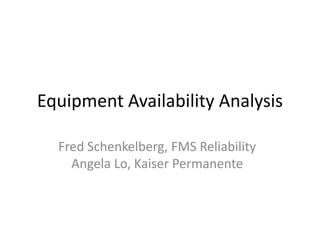Equipment Availability Analysis
•Als PPTX, PDF herunterladen•
0 gefällt mir•650 views
Presentation to the 2010 Fall Technical Conference
Melden
Teilen
Melden
Teilen

Empfohlen
Empfohlen
Poor layout design is determined as a major problem
in small and medium industry. These particular problems thus
affect the productivity and the line efficiency as well. In
automotive industries, assembly line is the major area to be
taken into consideration for increasing productivity. The focus
of this paper is to identify the bottleneck workstations in the
current layout and eliminate those activities that are taking time
on that workstations. The time study is done by using camera.
The current layout is redesigned by computing takt time and
processing times in each workstations. The case study shows how
the takt time calculation is done and from this takt time the
processing time is decided for all workstations. The time
consuming activities are reduced and thus the processing times
at all workstations is made possibly equal. The time reduction
increases productivity in the form of increased number of units
of production in the same previous time.
Line efficiency is also found to be improved which is described
with the terms Overall Line Efficiency (OLE) and First Pass
Yield (First Time Through) units.
PRODUCTIVITY IMPROVEMENT OF AUTOMOTIVE ASSEMBLY LINE THROUGH LINE BALANCING

PRODUCTIVITY IMPROVEMENT OF AUTOMOTIVE ASSEMBLY LINE THROUGH LINE BALANCINGInternational Journal of Technical Research & Application
Weitere ähnliche Inhalte
Ähnlich wie Equipment Availability Analysis
Poor layout design is determined as a major problem
in small and medium industry. These particular problems thus
affect the productivity and the line efficiency as well. In
automotive industries, assembly line is the major area to be
taken into consideration for increasing productivity. The focus
of this paper is to identify the bottleneck workstations in the
current layout and eliminate those activities that are taking time
on that workstations. The time study is done by using camera.
The current layout is redesigned by computing takt time and
processing times in each workstations. The case study shows how
the takt time calculation is done and from this takt time the
processing time is decided for all workstations. The time
consuming activities are reduced and thus the processing times
at all workstations is made possibly equal. The time reduction
increases productivity in the form of increased number of units
of production in the same previous time.
Line efficiency is also found to be improved which is described
with the terms Overall Line Efficiency (OLE) and First Pass
Yield (First Time Through) units.
PRODUCTIVITY IMPROVEMENT OF AUTOMOTIVE ASSEMBLY LINE THROUGH LINE BALANCING

PRODUCTIVITY IMPROVEMENT OF AUTOMOTIVE ASSEMBLY LINE THROUGH LINE BALANCINGInternational Journal of Technical Research & Application
Ähnlich wie Equipment Availability Analysis (20)
Lanner client TST discuss simulation application and benefit

Lanner client TST discuss simulation application and benefit
PRODUCTIVITY IMPROVEMENT OF AUTOMOTIVE ASSEMBLY LINE THROUGH LINE BALANCING

PRODUCTIVITY IMPROVEMENT OF AUTOMOTIVE ASSEMBLY LINE THROUGH LINE BALANCING
Standardised work for garment industry- Prakhar Jain

Standardised work for garment industry- Prakhar Jain
Application of value stream mapping tool to reduce wastes in bearing industry

Application of value stream mapping tool to reduce wastes in bearing industry
ATAGTR2017 Batch Workload Modelling and Performance Optimization 

ATAGTR2017 Batch Workload Modelling and Performance Optimization
Mba ii pmom_unit-1.4 process design, analysis & selection a

Mba ii pmom_unit-1.4 process design, analysis & selection a
Mehr von Accendo Reliability
Mehr von Accendo Reliability (20)
10-RCM has serious weaknesses industrial environment.pdf

10-RCM has serious weaknesses industrial environment.pdf
04-Equipment Experts Couldn't believe response.pdf

04-Equipment Experts Couldn't believe response.pdf
Equipment Availability Analysis
- 1. Equipment Availability Analysis Fred Schenkelberg, FMS Reliability Angela Lo, Kaiser Permanente
- 2. Overview • Bottling line – Multiple bottle sizes – Multiple flavors • Build to finished goods inventory – Mixed shipments of FG to distribution centers – Daily shipments – Broad variation in demand of bottle size and flavor
- 3. Introduction • Throughput directly related to inventory size • Inventory is expensive • Goal is to improve the throughput to equipment capabilities seen over long runs to short runs. How much inventory reduction is possible?
- 4. Existing Analysis • The filler (bottleneck) has the following values Given a 400 bottles / min equipment average capability
- 5. Desired Improvement • (Anecdotally) the line runs better over time • Improve the analysis to calculate MTBF over various length runs • Make the calculations time dependant
- 7. Filler - Time to Failure
- 8. Filler - Time to Repair
- 9. General Renewal Process • Assumptions – Time to first failure is known (Weibull) – Time to repair is negligible relative to runtime. • Permit modeling of repairs that are between – As good as new – As bad as old
- 10. Cumulative Failure Intensity vs Time
- 11. New MTBF Values Length of run 120 240 480 960 1440 (minutes) Cumulative 7.17 9.29 11.56 13.26 14.16 MTBF Instantaneou s 20.75 26.53 32.57 37.45 34.72 MTBF The long term MTBF value is 45.6, resulting in approximate 2.63 minutes to build 1000 units. Building the same inventory faster, permits the inventory reduction.
- 12. Results Length of run 120 240 480 960 1440 (minutes) Time to build 3.53 3.33 3.19 3.12 3.09 1000 units %Improveme nt 25.5 20.9 17.5 15.6 14.7 with 380/min For a 4 hour run (240 minutes) if the equipment is improved to a 380/minute throughput, there is at least a 20% inventory reduction
- 13. Summary & Conclusion • Using the GPP model to estimate MTBF for various run time and calculate throughput • The possible throughput improvement costs can now be balanced with potential cost savings • The improved performance visibility encouraged a study of the shift change and restart behavior
- 14. Contact Information Fred Schenkelberg Reliability and Management Consultant www.fmsreliability.com fms@fmsreliability.com +1 (408) 710-8248
